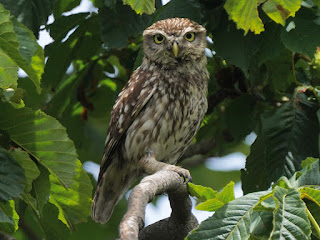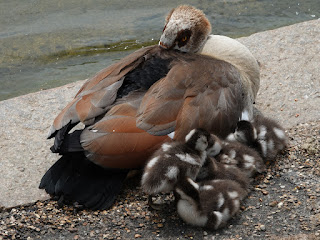At the Round Pond both the female Little Owl ...
... and the male could be seen on either side of the tree where owlets were calling, hidden in the leaves.
The male had seen someone who had annoyed him earlier (not me, I hasten to add) and was calling irritably.
At the Serpentine Gallery the female Little Owl finally appeared the third time I visited the tree.
The male never seems to appear. Probably he has a favourite tree that we haven't found.
A pleasing picture by Virginia of one of the owlets preening.
Most of the birds have stopped singing, but a sunny interval will start off a Song Thrush at any time of year.
A Great Tit ate a pine nut.
The Coot chicks in the Italian Garden are now very nearly adult size.
The chicks at Peter Pan are down to three, but even this number is surprising considering their reckless venturing all over the open lake.
A Moorhen looked out of the reed bed near the Italian Garden. I think there's a pair nesting here, but as usual they are being very secretive.
I finally saw a Moorhen chick on the island, the first this year -- but only because it strayed across the background and appeared out of focus in part of the next video. I haven't kept that bit in the edited video.
The number of Cormorants on the lake is slowly rising as this year's young fish grow to an interesting size. These three were at the Serpentine island.
Five half-grown Egyptian goslings preened together on the edge of the Serpentine, their downy feathers ruffled by the wind.
Smaller goslings sheltered behind their mother.
The hyper-aggressive male Mute Swan on the Serpentine chased a gosling under the landing stage.
Comma butterflies have appeared all over the park. One perched on a leaf in the Dell, another on the railings.
The Comma is so called because of the mark on its underwing.
A Blue-Tailed Damselfly rested on an iris leaf in the Italian Garden.



%202022%201a.jpg)









Are Little Owls said to 'mewl' in British English? In Spanish their voice is called 'mayar' (to say mau), cognate to cats' 'maullar' (to say meow, or rather miau in Spanish), on account of the sound similarity.
ReplyDeleteIncidentally, there is a very funny long poem in the Anthologia Latina (nº 762 in Riese's edition) listing how all the animal voices are called in Latin. It is summarised in pp. 127-129 here:
https://dialnet.unirioja.es/descarga/articulo/104725.pdf
As usual the author mistranslates noctua as barn owl; caccubire is the same as Greek kikkabau, which is the sound pattern the Greeks perceived in the call of the Little Owl.
I think the word 'mewl' died with Shakespeare ('the infant / Mewling and puking in his nurse's arms' -- though 'puking' persists as a vernacular term).
DeleteI've seen another list of animal sounds where the verbs are different:
Late antique/early medieval catalogue of animal sounds in Latin (as printed in Benediktson, “Polemius Silvius’ ‘Voces Varie Animantium’ and Related Catalogues of Animal Sounds”, Mnemosyne 53.1 [2000] 71ff):
Voces variae animantium:
Ouis balat, canis latrat, lupus ululat, sus grunnit, bos mugit, equus hinnit, asinus rudit, ursus saevit, leo fremit, elefans barrit, corvus croccit, merulus frindit, turtur gemit, turdus trucilat, anser clingit, grus gruuit, milvus linguit, apis bobit, hirundo minurrit, rana coaxat, populus strepit, ignis crepitat, cursus aquarum murmurat, ferrum stridit, aes tinnit.
I think the authors of these lists made up a lot of things as they liked.